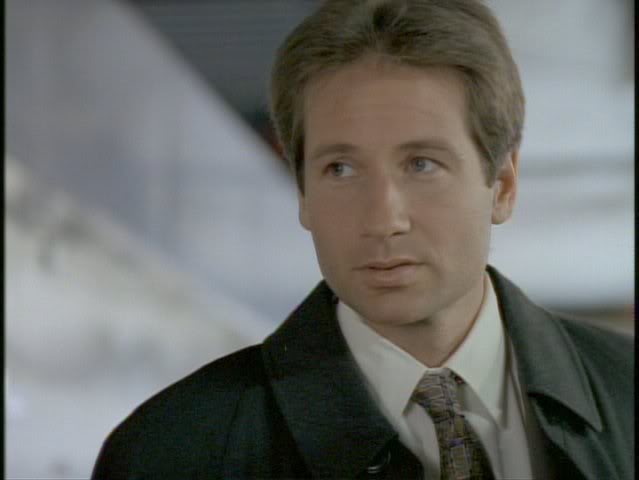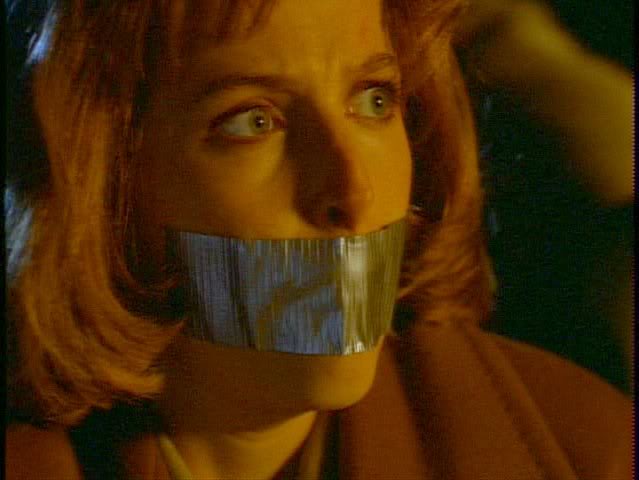CTP Episode of the Day - 11.29.06 – Our Town
Today's Cherished Episode: Our Town (2x24)
Original Air Date: May 12, 1995
Written By: Frank Spotnitz
Directed By: Rob BowmanMulder and Scully investigate a murder in a small Southern town and its strange secrets surrounding a chicken processing plant.
"Scully, I think the good people of Dudley have been eating more than just chicken."
Some "Our Town" Tidbits & Musings:
-- This episode shares its name with an American classic play by Thornton Wilder. Wilder's Our Town (1938) chronicles the lives of the townspeople of Grover's Corners, New Hampshire, during three time periods -- 1901, 1904, and 1913. The omnipresent Stage Manager stoically narrates on a nearly bare stage the inevitable and yet unpredictable cycle of life, death, and all of the seemingly mundane things in-between. It is the simplicity of the play and the honesty of the prose that is so riveting and ultimately heartbreaking in its scope. The play won the 1938 Pulitzer Prize.
-- The town in the X-Files's "Our Town," Dudley, Arkansas, was certainly a bit different. And Wilder's play was not the inspiration for this episode. Writer Frank Spotnitz began with the premise of cannibalism in a small town, which was inspired by his fondness for the 1955 Spencer Tracy movie Bad Day at Black Rock, which also dealt with a town hiding a terrible (if slightly more mundane) secret.
-- Vince Gilligan also used Bad Day at Black Rock as the inspiration for Season 8's "Roadrunners."
-- Spotnitz came across an article in UCLA's research library about salamanders getting sick from eating other salamanders, then turned to his brother Seth, a neurologist, who suggested the rare disease that the townspeople contract from eating the chicken plant inspector. "It's very convenient," Spotnitz said of his brother's vocation. "He's been extremely helpful."
-- Interestingly, some of the material regarding cannibalistic tribes -- and the discovery of rounded human bones that appeared to have been boiled in pots -- related to research Spotnitz had done about the Anasazi, the native people Chris Carter referred to in the subsequent episode. The name Chaco Chicken, in fact, was derived from Chaco Canyon, New Mexico, where that tribe was believed to have lived and such bones were found.
-- This was Spotnitz's second X-Files script and his first solo non-mythology writing effort. The first episode he wrote was Season 2's "End Game."
-- The Chaco Chicken motto -- "Good People, Good Chicken" certainly had an ominous double meaning.
-- Despite rumors to the contrary, the severed heads in the trophy case belonging to Walter Chaco were not portraits of various real people. They were made up by the makeup department.
-- This was only the second episode in which Mulder killed someone.
-- Mulder's beck-and-call boy "Danny" made another non-appearance; he ran the missing persons check for Mulder.
-- Oopsie! Scully always did an excellent job with her autopsies, but in "Our Town" she managed to get a specimen from Paula Gray's brain without even cutting into her head. We saw Paula's head from every angle, and Scully's autopsy didn't even leave a scar.
-- According to writer Frank Spotnitz, many of the characters in this episode were named for real cannibals.
-- Mulder said that the events occurred near I-10; however, I-10 is nearly 200 miles south of Arkansas's border in southern Louisiana.
-- Creutzfeldt-Jakob disease (CJD) is a rare, degenerative, invariably fatal brain disorder. Typically, onset of symptoms occurs at about age 60. There are three major categories of CJD: sporadic CJD, hereditary CJD, and acquired CJD. There is currently no single diagnostic test for CJD. The first concern is to rule out treatable forms of dementia such as encephalitis or chronic meningitis. The only way to confirm a diagnosis of CJD is by brain biopsy or autopsy. In a brain biopsy, a neurosurgeon removes a small piece of tissue from the patient's brain so that it can be examined by a neurologist. Because a correct diagnosis of CJD does not help the patient, a brain biopsy is discouraged unless it is needed to rule out a treatable disorder. While CJD can be transmitted to other people, the risk of this happening is extremely small. About 90 percent of patients die within one year. In the early stages of the disease, patients may have failing memory, behavioral changes, lack of coordination and visual disturbances. As the illness progresses, mental deterioration becomes pronounced and involuntary movements, blindness, weakness of extremities, and coma may occur.
-- Before the mad cow disease epidemic in the mid-1990s, few people had heard of Creutzfeldt-Jakob disease. That's because Creutzfeldt-Jakob disease, an invariably fatal, degenerative brain disorder, was always considered rare. Worldwide, doctors typically diagnosed one case of Creutzfeldt-Jakob disease per million people each year, most commonly in older adults. That changed a decade ago when an unusually large number of people in Great Britain developed what appeared to be CJD. Most were relatively young, and all had eaten meat from cattle suspected of having bovine spongiform encephalopathy (BSE), the medical term for mad cow disease.
-- Scientists eventually concluded that the new ailment — named variant Creutzfeldt-Jakob disease (vCJD) — was a form of Creutzfeldt-Jakob disease resulting from exposure to BSE. Since then, a number of cases of vCJD have been linked to contaminated beef in Great Britain and in other countries, including Spain, Portugal, France and Germany. Although "classic" Creutzeldt-Jakob disease hasn't been linked to infected beef, it's similar to vCJD in many respects. No treatment exists for either type of CJD, and nothing can slow the progression of the disease.
-- The townspeople contracted Creutzfeldt-Jakob disease from the bodies they consumed and it showed up in the brain tissue within a matter of weeks. Realistically, the rare disease would take several years to even be detectable. Also, the heads of all the victims were kept in Chaco's souvenir case, so it is hard to see how their diseased brain tissue could make it into the stew that the town shared which ultimately infected them.
-- Mulder's line, "If a fool would persist in his folly, he would become wise" is text is from William Blake's Proverbs of Hell. (One of Mulder's "hurled cliches" in "The Unnatural" -- "The road of excess leads to the palace of wisdom" -- is from the same poem.)
-- Actor Gary Grubbs (Sheriff Arens) would turn up again the in Fight the Future; but outside of his X-Files connections, Grubbs has had a long and successful acting career in television and movies. (I always remember him -- and his very distinctive southern accent -- as the prosecutor in the 1984 TV miniseries Fatal Vision based on Joe McGinniss's novel about Jeffrey MacDonald, a former Green Beret Army doctor accused of murdering his pregnant wife and two daughters.) Grubbs had a recurring role as Harlin Polk in Will & Grace and has recently been seen mostly on the big screen in such films as Ray, Glory Road, All the King's Men, and the just released Deja Vu.
-- Quantum Leap fans might recognize Caroline Kava (Doris Kearns) for her role as Sam Beckett's mom Thelma in the popular episode "The Leap Home." She also played Tom Cruise's mom in Born on the Fourth of July.
-- John Milford (Walter Chaco) was credited for the original design of the Hollywood Walk of Fame. Milford died in August 2000 of skin cancer.
-- Timothy Webber, who played Jess Harold, has a recurring role as Jerome in the ABC series Men in Trees.
-- Once & Future Retreads: Carrie Cain-Sparks (Maid) was the Train Station Clerk in "Nisei" and the Duty Nurse in "Small Potatoes." Gary Grubbs (Sheriff Tom Arens) was Fire Captain Miles Cooles in "Fight the Future." John Maclaren (George Kearns) was the Doctor in "Talitha Cumi." Hrothgar Mathews (Mental Patient) was Jack in "The Jersey Devil," Man on Phone in "The Host," and Galen Muntz in "Talitha Cumi." Gabrielle Miller (Paula Gray) was Brenda J. Summerfield in "Syzygy." Robert Moloney (Worker) was Bruce Bearfeld in "Tempus Fugit." Robin Mossley (Dr. Vance Randolph) was Dr. Joe Ridley in "Young at Heart," and Dr. Kingsley Looker in "Tunguska" and "Terma." Timothy Webber (Jess Harold) was Detective Talbot in "Tooms" and Dr. Paul Farraday in "Quagmire."
From the official Chicken Joke Web Site:
Why did the chicken cross the road?
Fox Mulder: "It was a government conspiracy."
(Thanks to chrisnu for today's episode pics.)
-- Earlier this year, a good friend of my family passed away after an illness of more than a year. When his illness began, he had been a very active, very healthy gentleman and avid golfer who had retired to Florida with his wife after 30+ years with the postal service. The symptoms started with bouts of forgetfulness, weakness in his arms and legs, and difficulty talking, and doctors thought he had suffered a stroke. He was hospitalized for months in Florida, his condition gradually worsened (including severe mood swings), and he was eventually transferred to Johns Hopkins in Baltimore. Many types of treatment were tried but none were successful, and he continued to deteriorate, including very violent and vitriolic behavior where he would have to be restrained in a straightjacket. (It was so debilitating and frightening that his wife told me later that every night she prayed for him to die.) His daughter-in-law called me to tell me he had passed away and said that the autopsy revealed he died of "something you've never heard of" -- Creutzfeldt-Jakob disease. Because of "Our Town," I said to her, "actually, I have heard of that." So for me, "Our Town" will always have that sad footnote.
Please share your first impressions, favorite (or cringe-worthy) moments, classic lines, favorite fanfic, nagging questions, repeated viewing observations, etc., as today we celebrate "Our Town."
Polly







